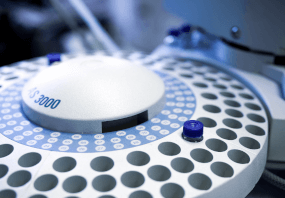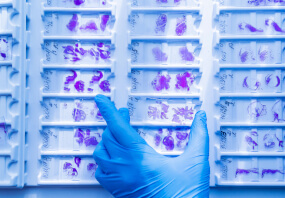General description
Laminin, a 900kD (approx.) complex extracellular glycoprotein, is the most abundant structural and biologically active component present in the basement membranes. It is a cell substrate adhesion protein and thus has a crucial role in promoting neurite regeneration and modulating cellular functions like differentiation, cell shape and cell movement. Monoclonal Anti-laminin antibody can be used in immunohistochemistry to classify various disease processes involving basement membranes, to mark blood vessel walls of different species and to determine the origin and classification of human tumours. It can also be used in dot blot assays. Mouse anti- laminin antibody reacts specifically with purified human laminin but not with collagen IV, fibronectin, vitronectin or chondroitin sulfate types A, B, and C.
Monoclonal Anti-Laminin (mouse IgG1 isotype) is derived from the hybridoma produced by the fusion of mouse myeloma cells and splenocytes from an immunized mouse. Laminin, the most abundant structural and biologically active component in basement membranes, is a complex extracellular glycoprotein with an approximate molecular weight of 900 kDa. Laminin is composed of one A chain (400 kDa) one B1 chain (215 kDa) and one B2 chain (205 kDa) all held together by disulfide bonds. Laminin is only found in significant quantities in basement membranes, the thin extracellular matrices that surround epithelial tissue, nerve, fat cells and smooth, striated and cardiac muscle.
Immunogen
human laminin.
Application
Monoclonal Anti-Laminin antibody produced in mouse has been used in:
- immunohistochemistry to stain matrix proteins
- double immunofluorescence staining
- indirect immunofluorescence
- immunogold labelling for electron microscopy
Monoclonal Anti-laminin antibody can be used in indirect immunostaining to determine the distribution of laminin. It may also be used for ELISA, Immunofluorescence and western blotting.
Biochem/physiol Actions
Laminin is a cell substrate adhesion protein and thus has a crucial role in promoting neurite regeneration and modulating cellular functions like differentiation, cell shape and cell movement because it appears to be an important cell substrate adhesion protein. It plays an important role in many aspects of the cell biology. Variations in the expression of this protein have been observed in embryogenesis, organogenesis, post traumatic healing and cancer.
Disclaimer
Unless otherwise stated in our catalog or other company documentation accompanying the product(s), our products are intended for research use only and are not to be used for any other purpose, which includes but is not limited to, unauthorized commercial uses, in vitro diagnostic uses, ex vivo or in vivo therapeutic uses or any type of consumption or application to humans or animals.
Shipping Information:
Dry Ice Surcharge & Ice Pack Shipments: $40
More Information: https://cenmed.com/shipping-returns
- UPC:
- 51111862
- Condition:
- New
- Availability:
- 3-5 Days
- Weight:
- 1.00 Ounces
- HazmatClass:
- No
- MPN:
- L8271-100UL
- Temperature Control Device:
- Yes












